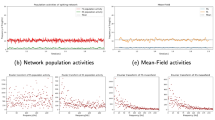Abstract.
In extending our previous results demonstrating critical fluctuations in electropathophysiological brain activity prior to onset of partial epileptic seizures, we used once again Haken’s approach to self-organized complex systems, which resorts to identifying an order parameter. A renormalized density in phase space and a renormalized differential density were defined and substituted for the Lerner density, which we used previously. Fluctuations in electropathophysiological activity, consisting of periods of high activity recorded from both depth and scalp electrodes in six presurgical patients, were characterized on different time scales. Extension in space of the fluctuations was characterized by observing their synchronous occurrence in different areas of the brain. By simultaneously establishing the fluctuations’ criticality, we were observing “synchronous instabilities”. Criticality followed from characterizing the time course of the synchronously arising fluctuations, when approaching seizure onset (i) by their slowing, for the longer-lasting ones (up to about 2 min), and (ii) by their increase in rate of production, for those of shorter duration (up to 20–30 s). Critical behavior may be displayed in favorable cases over more than 1 h prior to seizure onset. Other effects are also described that in some cases may interfere with the simple time course of fluctuations and must be given further consideration, particularly with a view to application to seizure anticipation. Because periods of high activity are involved, any marker of increased electropathophysiological activity in the brain may, in principle, play the role of an order parameter or of an approximate order parameter, e.g., a signal’s root-mean-square amplitude, or its excess energy content. Such markers may be put to use for the fluctuations they display or merely for their average time evolution prior to seizure onset. We compared the time evolution, prior to onset, of the excess production rate of synchronies and of the signals’ excess energy content, both averaged over signal sections of a chosen duration. In view of potential noninvasive applications, those scalp electrodes showing effects similar to the observations we made at the epileptogenic focus were identified, and the time course of their order parameters prior to seizure onset was analyzed.
Similar content being viewed by others
Acknowledgments.
We are most indebted to Jean-Paul Macher (Rouffach) for his kind support, to Jack Foucher (Strasbourg) for the transfer of data from Grenoble to Rouffach, and to the anonymous reviewer for helpful suggestions. We are grateful to Gilbert Rinaudo, Geoffrey Viardot, and Damien Maurice (Rouffach) for their help and to Christian Marescaux (Rouffach) and Doris Boronowski (München) for valuable comments.
Author information
Authors and Affiliations
Corresponding author
Rights and permissions
About this article
Cite this article
Cerf, R., Ouasdad, E. & Kahane, P. Criticality and synchrony of fluctuations in rhythmical brain activity: pretransitional effects in epileptic patients. Biol. Cybern. 90, 239–255 (2004). https://doi.org/10.1007/s00422-004-0463-9
Received:
Accepted:
Published:
Issue Date:
DOI: https://doi.org/10.1007/s00422-004-0463-9




